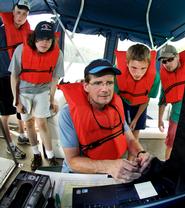
Hamilton College is situated roughly 30 miles from Green Lake, a rare meromictic lake in Onondaga Country. This lake is considered special due to the segregated nature of its water and multiple base layers of sediment that have remained preserved over the past thousands of years. This summer, Kevin Boettger ’14 and Matt Brzustoski ’15 studied the lake with Associate Professor of Biology Michael McCormick to identify its unique characteristics and features.
Lakes are typically holomictic, meaning their waters undergo seasonal mixing at least once every year. The water in meromictic lakes, however, possesses stratifying layers that prevent them from reaching uniform temperatures and having mixing occurring. According to Boettger, the research team hoped to develop a “full, high resolution understanding of all the chemical differences,” that are present between each layer of water.
To do so, the team spent multiple days collecting samples from different depths in the lake. They were looking to obtain a sufficient number of samples to identify every microbial population that currently exists in the still and undisrupted waters. The team noted that McCormick was “very good at structuring our projects, jumping in when he needed to and assigning realistic goals,” throughout the summer.
While the water is stratified into multiple layers, the group simplified the division explanation and described three significant depth ranges. A salty, dense layer of water containing sulfides rests at the bottom, which has preserved the rich chemical history of Green Lake. The lake’s surface is composed of fresh water sourced from Round Lake, which does not contain the sulfides found at the bottom.
Between these two stratifications sits a thinner sheet containing sulfur-reducing bacteria that can essentially “breathe” sulfates rather than oxygen. As you dive further into the lake, you will also find more cyanobacetria, otherwise known as blue-green algae.
To collect samples from each region, McCormick’s students in his microgeobiology course designed a remote operated vehicle (ROV). While building the ROV was relatively straightforward, creating a sediment-collecting attachment for the vehicle proved more difficult. The team decided to attach an electronically controlled syringe to the front of the ROV, allowing them to obtain samples at precise depths and locations within the lake.
They hope to map the depths of each layer, as well as identify the microorganisms that live in each zone to better understand the chemical composition of the lake’s divided sections. In doing so, the group will uncover what environmental conditions support different bacterial growth and how this can improve further scientific research with similar organisms.
The team is looking forward to contributing to an academic library that involves a rare lake that many people are not able to study. They are still analyzing their samples and Boettger plans on continuing this research through to his senior thesis this year. Brzustoski concluded that obtaining practical lab experience is “invaluable for anyone like myself, who wants to pursue a career in scientific research.”
Boettger is a graduate of Westwood High School (Mass.) and Brzustoski is a graduate of Comsewogue High School (N.Y.).
